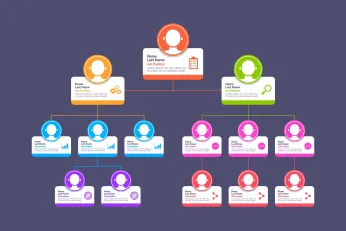تمكين المبيعات مقابل عمليات المبيعات: ما الفرق بينهما؟
Sales enablement equips teams with training and content, while sales operations focus on strategy and processes. Knowing the difference between sales enablement and sales operations improves efficiency and revenue.
في هذه الصفحة
A successful sales strategy depends on more than just skilled sales reps—it requires the right structure, tools, and processes to support them. This is where sales enablement and sales operations come in. While both functions aim to improve sales performance, they serve different purposes. Without a clear understanding of the difference between sales enablement and sales operations, businesses may face inefficiencies that slow down revenue growth.
Sales enablement ensures sales teams have the proper training, content, and technology to engage prospects and close deals effectively. Sales operations, on the other hand, focus on the processes, data, and analytics that keep sales teams organized and efficient. While their responsibilities differ, both are critical in improving sales effectiveness and helping businesses scale.
In this guide, we’ll break down sales enablement vs sales operations, highlighting their unique roles, key differences, and how they work together to create a high-performing sales team.
ما هو تمكين المبيعات؟
Sales enablement is a comprehensive strategy that integrates coaching, training, content, technology, processes, and activities to support and empower sales representatives in advancing sales opportunities through informed interactions with prospects.
In essence, sales enablement aims to enhance the effectiveness of salespeople by providing them with the necessary support and training.
Another way to look at sales enablement is by aligning individuals, procedures, and objectives through relevant training, coaching, content, and communications.
The concept revolves around delivering appropriate actions to the right individuals at the right moment, directly correlating with improved sales performance. By aligning people, processes, and priorities with go-to-market metrics and revenue objectives, sales enablement can significantly enhance revenue generation, deal size, and win rates.
ما أهمية تمكين المبيعات؟
تمكين المبيعات أمر بالغ الأهمية لعدة أسباب:
- Supporting overall seller productivity: By providing sales reps with the right tools, training, and resources, sales enablement helps them become more efficient and effective in their roles. This leads to higher productivity and better sales outcomes.
- Reducing sales rep turnover: Sales enablement programs focusing on continuous learning and skill development can improve job satisfaction and engagement among sales reps. This, in turn, can reduce turnover rates and ensure a more stable and motivated sales team.
- Providing an accessible knowledge base: Sales enablement creates and maintains a central repository of knowledge, best practices, and resources that sales reps can easily access. This helps them stay informed, answer customer questions more effectively, and close deals faster.
- Keeping potential customers informed: Sales enablement ensures that sales representatives have access to up-to-date and accurate information about products, services, and industry trends. This enables them to educate potential customers effectively, address their concerns, and build trust, ultimately leading to more successful sales engagements.
- Refining sales enablement through measurement: By measuring sales effectiveness over time, companies can identify areas for improvement in their sales enablement strategies. This data-driven approach allows organizations to refine their sales enablement efforts, optimize resources, and drive better results.
مسؤوليات أخصائي تمكين المبيعات
A sales enablement specialist plays a crucial role in equipping sales teams with the tools, resources, and strategies they need to close deals effectively. From training and content creation to streamlining processes, their work directly impacts sales performance. Here are the core responsibilities that define this role.
1. Facilitating communication between sales, marketing, product teams, and senior management
A sales enablement specialist is a crucial link between the sales, marketing, product teams, and senior management. They facilitate communication, collaboration, and alignment of strategies to ensure all departments work towards common goals.
2. Developing content tailored for the sales team
They are tasked with creating customized content specifically for the sales team. This content is designed to address the unique needs and challenges faced by sales professionals, helping them engage with customers more effectively and drive sales.
3. Educating and guiding sales representatives on utilizing sales enablement materials:
A sales enablement specialist is responsible for training and mentoring sales representatives on effectively using sales enablement content. This includes guiding how to incorporate the content into their sales processes and strategies and helping them understand the value and benefits of the content for their sales efforts.
4. Structuring and enhancing sales enablement content
They are also tasked with organizing and optimizing it. This involves categorizing and structuring the content in a way that is easy for sales reps to access and use, as well as ensuring that the content is up-to-date and aligned with the needs of the sales team and the target market.
5. Performing market research and collecting feedback
Sales enablement specialist is involved in conducting market research and gathering feedback. This includes staying informed about market trends, competitor activities, and customer preferences, as well as collecting feedback from sales reps and other stakeholders to improve the effectiveness of sales enablement content and strategies continuously.
ما هي الأدوات اللازمة لتمكين المبيعات؟
Here are the essential tools that streamline sales enablement, helping teams access the right resources, automate processes, and close deals faster. These tools improve collaboration, enhance productivity, and ensure sales reps have everything they need to engage prospects effectively.
1. LevelEleven
LevelEleven is a sales management tool that tracks activities, analyzes sales strategies, and integrates with Salesforce. It allows you to create custom contests, provides dashboards for sales leaders, and features Channel 11 TV for real-time updates on sales activities.
2. ميمبراين
Membrain enhances sales effectiveness by enabling teams, executing processes, coaching, and optimizing strategies. It offers complete sales enablement, assisting with processes, training, content management, and automation. The platform integrates with Salesforce, Hubspot, and Zendesk, and provides a comprehensive overview of sales projects with the Story Stream feature.
3. واتفيكس
Whatfix offers in-app guidance for training sales reps, simplifying learning for complex applications like Salesforce. It reduces the need for repeated training content creation and helps retain knowledge with quick, interruption-free guides. The platform also provides real-time walkthroughs and a Self-Help widget to lower support costs.
4. Mindtickle
Mindtickle is a platform that helps companies increase revenue by improving sales knowledge and behaviors. It helps you create programs that reinforce knowledge, analyze sales meetings, and enhance the sales process.
With Mindtickle, you can identify successful sales behaviors that lead to positive outcomes. It provides personalized training and practice for each salesperson to adopt these behaviors.
5. الزلازل
Seismic is a platform that centralizes sales resources and content, offering global version control and approval tools. It provides personalized content for each buyer interaction, enhancing sales productivity.
Seismic curates news, competitive information, and product updates to empower sales teams. It also offers predictive content recommendations for the selling process.
ما هي عمليات البيع؟
Sales Operations covers various tasks such as managing leads, developing sales strategies, and aligning territories. It also includes improving sales processes, creating compensation plans, implementing sales automation, providing training, and analyzing data.
The primary focus of a sales operations team is sales and operations planning (S&OP). This involves coordinating across departments and updating sales and budget forecasts to ensure all aspects of the business are working together smoothly.
The goal of sales operations is to streamline the sales process, allowing sales team members to focus on their core tasks without distractions. Sales ops teams must manage systemic planning, use technological tools effectively, and provide company-wide training to achieve this goal.
Why is sales operations important?
Sales operations is crucial for several reasons:
- Collaboration: It demonstrates measurable benefits by bringing different teams together to achieve common goals. When teams collaborate effectively, they can achieve better results and improve overall performance.
- S&OP clarity: Sales and Operations Planning (S&OP) creates a clear outline of how different departments can work together. This alignment ensures that everyone is on the same page, reducing confusion and improving efficiency.
- Greater organization: Sales operations lead to greater organization within the sales team and across departments. This organization leads to clarity in roles, responsibilities, and processes, resulting in smoother operations and better outcomes.
Sales operations roles and responsibilities
Sales operations teams handle the processes, tools, and strategies that keep a sales team running efficiently. Their role goes beyond administrative support, focusing on data-driven decisions, process improvements, and sales enablement. Here’s a breakdown of their key responsibilities.
1. Sales data management
In a sales operations role, one of the key responsibilities is managing sales data. This involves ensuring that the data is accurate and up-to-date, as well as maintaining and updating sales databases. Additionally, generating regular reports for the sales team and management and analyzing sales data to identify trends and insights are crucial aspects of this role.
2. التنبؤ بالمبيعات
Sales operations professionals collaborate with sales and marketing teams to develop accurate sales forecasts. This includes analyzing historical sales data and market trends to predict future sales, and adjusting forecasts based on changes in market conditions or business priorities. Sales forecasts are then provided to senior management to assist in decision-making.
3. Sales representative support
Sales operations professionals provide support to sales representatives. This includes training and onboarding new sales representatives, assisting them with questions related to products, processes, or tools, and collaborating with the marketing team to develop sales collateral and presentations.
Ultimately, the goal is to support sales representatives in achieving their sales targets and driving business growth.
4. Performance management
Sales operations play a crucial role in the performance management of a sales team. This includes collaborating with senior management to establish performance targets and then monitoring individual and team performance closely.
By identifying areas for improvement, sales operations can implement strategies to enhance sales performance, providing ongoing feedback and coaching to help sales representatives achieve their targets effectively.
5. Sales team organization
In terms of sales team organization, sales operations is responsible for designing and implementing sales territories and quotas. They allocate resources strategically to maximize sales productivity and organize sales meetings and training sessions to keep the team informed and motivated.
Collaboration with other departments, such as marketing and product teams, ensures alignment with sales objectives.
6. Sales incentives management
Sales incentives are rewards given to salespeople for achieving specific goals or targets. Compass is a platform used to manage sales incentives and commissions. It could track sales performance, calculate incentives based on predefined rules, and provide visibility to both the sales team and management.
Sales incentives are crucial for motivating salespeople to achieve their targets and drive performance.
7. Sales motivation
Sales motivation refers to the techniques or strategies used to keep the sales team engaged, enthusiastic, and focused on their goals. One of the best ways to motivate is by offering Xoxoday gift cards and experiences as a way to motivate the sales team.
These rewards provide tangible benefits that go beyond monetary compensation, such as memorable experiences or the ability to choose a reward that suits individual preferences. This approach helps boost morale, maintain high levels of motivation, and improve overall sales performance.
What tools are needed for sales operations?
Here are the essential tools that keep sales operations running smoothly, from tracking performance to managing pipelines. The right mix of technology helps teams stay organized, close deals faster, and maintain clear communication across the sales process.
1. Clari
Clari is a tool for sales teams that uses data science to help them sell better and faster. It can predict sales patterns, improve how teams communicate, and provide useful insights to close deals quickly. Key features include predicting sales trends, managing forecasts, sending tips directly to reps' phones, and coaching with data-driven strategies.
2. Salesforce Sales Cloud
Sales Cloud, a part of Salesforce, provides a live overview of your team's sales predictions. It allows for real-time adjustments and gives visibility to managers at all levels.Salesforce claims that Sales Cloud offers several advantages, such as providing an accurate view of the entire sales pipeline, tracking individual sales performance, and managing forecasts for complex sales teams.
3. Compass
Compass, a sales commission automation platform, streamlines sales operations by automating incentive programs and commission calculations, reducing errors, and saving time. It offers clear analytics on sales performance, supports scalability, and integrates seamlessly with CRM and ERP systems. This enhances operational efficiency and drives revenue growth, making Compass essential for effective sales management.
4. Badger Maps
Badger Maps is software for field sales reps, offering route mapping and territory design. It allows reps to view customer information on a map, identify high-potential areas, and automate territory mapping and route optimization. It integrates with any CRM and caters to businesses of all sizes.
Key differences between sales enablement and sales operations
Understanding the key differences between sales enablement and operations helps businesses structure their sales teams effectively. While sales enablement focuses on training, content, and tools, sales operations handle strategy, processes, and data management. Aligning both functions ensures a more efficient and results-driven sales approach.
Both sales enablement and sales operations are essential for a high-performing sales team. While one focuses on empowering sales reps, the other ensures they have the right infrastructure to succeed.
How sales enablement and sales operations work together
Sales enablement and sales operations collaborate closely to support the sales team and drive revenue. While sales enablement focuses on preparing and educating sales reps, sales operations ensure the smooth execution of the sales process. Both teams work closely with management to assist reps throughout the sales cycle, understanding ideal prospects, the customer journey, and deal closure to facilitate sales effectively.
It's important to note that rather than competing, sales enablement and operations complement each other. Sales enablement and operations collaborate on change management plans, including training, measuring adoption, and providing resources. They coordinate activities like office hours and Q&A sessions. This collaboration ensures that both teams support the sales force effectively without duplicating efforts.
Effective communication is crucial. Sales operations should share the sales strategy and success metrics, while enablement must remain transparent about marketing initiatives and training content. This ongoing communication helps both teams align their efforts and contribute to a successful sales strategy.
To sum up, sales enablement and sales operations, though separate, are more effective when aligned. Operations optimize tools and technology, while enablement enhances sales rep effectiveness in buyer interactions. Together, they can significantly improve productivity and efficiency in the sales process.
Case Study 1: Enhancing team dynamics with innovative training solutions
This case study examines the successful implementation of Bigtincan’s onboarding and training solutions by one of the oldest and loudest teams in the NBA. The initiative aimed to streamline the training process, enhance knowledge sharing among team members, and optimize coaching strategies to maintain a competitive edge.
التحديات
The team faced several challenges that affected their operational efficiency and performance:
- Inconsistent Training: New and existing team members encountered varied training experiences, which led to inconsistencies in knowledge and skills across the team.
- Ineffective Communication: Poor communication channels hindered effective knowledge sharing and collaboration among players and coaching staff.
- Outdated Onboarding Processes: The traditional onboarding process was time-consuming and failed to engage team members effectively, impacting their initial experience and long-term performance.
الحلول
To address these challenges, the team collaborated with Bigtincan to implement a comprehensive solution:
- Unified Training Platform: Bigtincan provided a centralized platform that standardized training materials and methods, ensuring consistency across all team levels.
- Enhanced Communication Tools: The solution included advanced communication tools that facilitated better interaction among players and coaches, improving the overall strategy formulation and execution.
- Interactive Onboarding Experience: The new onboarding process was designed to be engaging and informative, integrating multimedia and interactive content to enhance learning and retention.
النتائج
The implementation of Bigtincan's solutions led to significant improvements:
- Improved Performance Consistency: With standardized training, the team members consistently performed more, reducing the gap between new and existing players.
- Increased Engagement and Collaboration: The enhanced communication tools fostered a more collaborative environment, where knowledge and strategies were shared freely, leading to innovative approaches and better game plans.
- Reduced Onboarding Time: The revamped onboarding process reduced the time required to bring new members up to speed, allowing them to contribute to the team's success sooner.
Case Study 2: Transforming sales operations with Salesforce CRM
This case study examines the transformation of a company's sales operations through the implementation of Salesforce CRM. The company faced numerous challenges in managing its sales processes, which affected its overall performance and customer relations.
التحديات
The company encountered several significant issues before implementing Salesforce CRM:
- Fragmented customer data: Information about customers was scattered across different platforms, leading to inefficient sales processes and poor customer service.
- Inefficient lead management: Sales leads were not being tracked systematically, resulting in missed opportunities and low conversion rates.
- Lack of sales analytics: There was an absence of real-time analytics, making it difficult to measure sales performance and make data-driven decisions.
الحلول
To address these challenges, the company implemented Salesforce CRM with the following strategies:
- Centralized customer data: Salesforce CRM centralized all customer information into a single platform, improving access to data and enhancing customer service.
- Automated lead management: The CRM system automated the tracking and nurturing of leads, which improved lead conversion rates and sales efficiency.
- Advanced sales analytics: The implementation of advanced analytics tools within Salesforce allowed for real-time performance tracking and better strategic planning.
النتائج
The adoption of Salesforce CRM transformed the company’s sales operations with remarkable outcomes:
- Enhanced customer relations: Centralized data improved the quality of customer interactions, leading to higher customer satisfaction and retention rates.
- Increased sales efficiency: Automated lead management resulted in a higher conversion rate and more effective sales processes.
- Data-driven decision making: Access to real-time analytics empowered the sales team to make informed decisions, significantly enhancing sales strategies and outcomes.
استنتاج
While sales enablement and sales operations are distinct functions within a sales organization, they are both essential for driving success. Sales enablement empowers sales teams with the right tools, training, and resources to engage effectively with customers.
On the other hand, sales operations streamline the sales process, optimize sales tools, and ensure the efficiency of sales activities.
Organizations can better leverage their strengths to maximize sales performance by understanding each function's unique roles and responsibilities. A harmonious collaboration between sales enablement and operations is key to achieving sales excellence and driving business growth.














